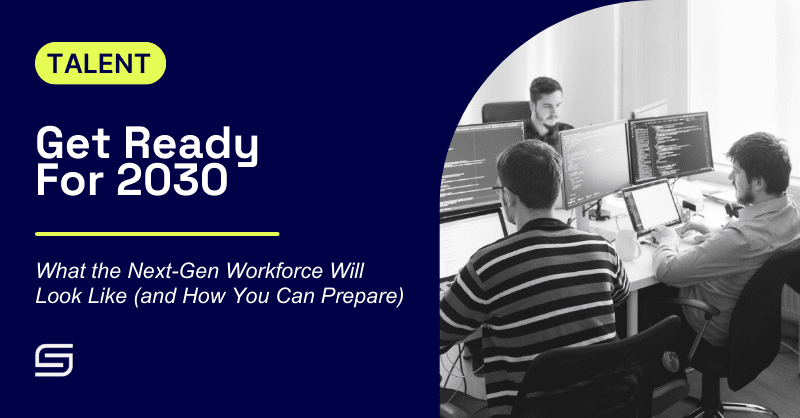Get Ready For 2030: What the Next-Gen Workforce Will Look Like (and How You Can Prepare)

By 2030, the global workforce will look dramatically different.
AI-driven automation, demographic shifts, and evolving employee expectations will redefine how companies attract, train, and retain talent.
Key data predicts some key trends to watch out for, and how you can adapt now for success in 2030 and beyond.
The Key Trends Shaping the Workforce of 2030
1. AI and Automation Will Reshape Jobs
AI is transforming the workplace, automating repetitive tasks, and augmenting human capabilities. According to the World Economic Forum, 85 million jobs will be displaced by automation by 2025, but 97 million new roles will emerge, requiring a shift in workforce skills.
- AI will be embedded in 70% of new applications by 2030.
- 25% of routine tasks are already robotized by AI
- 23% of current jobs are expected to change by 2027
- 69 million new jobs are expected to be created after the AI transition
What This Means:
Companies must invest in upskilling employees to work alongside AI rather than be replaced by it. Roles requiring uniquely human skills like problem-solving, critical thinking, and emotional intelligence will become more valuable.
2. The Workforce Will Be More Skills-Based, Not Degree-Based
Traditional hiring models that prioritize degrees over skills are becoming obsolete. By 2030, 65% of all jobs will require skills that aren’t widely taught in today’s education system.
Skills-based hiring is gaining traction. Major employers like Google, IBM, and Walmart have already shifted toward hiring based on demonstrated competencies.
Apprenticeships and on-the-job training will play a larger role. Industries facing severe talent shortages, like tech and healthcare, are adopting “hire-train-deploy” models to develop talent internally.
What This Means:
Enterprises need to rethink hiring criteria, prioritize skills assessments, and build internal talent pipelines through structured training and apprenticeships.
3. Demographics and Workforce Composition Will Shift
The global workforce is aging, but Gen Z and Millennials will dominate the labor market by 2030. Companies will need to adjust their workplace culture to meet the expectations of a digitally native generation.
- Millennials and Gen Z will make up 75% of the workforce by 2030.
- The number of workers over age 60 will increase, requiring new strategies for knowledge transfer.
- 74% of employees said they are ready and willing to learn new skills or re-train to remain employable in the future.
What This Means:
Companies must embrace digital collaboration tools, flexible work arrangements, and leadership development programs that support multigenerational teams.
4. The Rise of the Green Economy Will Create New Job Demands
Sustainability isn’t just a corporate responsibility initiative, it’s a job creator. The shift toward green energy and carbon neutrality will drive demand for new skill sets.
- The green economy will generate 24 million jobs globally by 2030 (ILO).
- Demand for renewable energy engineers, sustainability consultants, and ESG specialists will surge.
- Companies will face increasing pressure to integrate sustainability into their operations.
What This Means:
Enterprises must incorporate sustainability training into workforce development and align business strategies with environmental goals.
Preparing for 2030: Strategies for Enterprises
1. Adopt a Skills-First Hiring and Training Approach
Traditional hiring practices are failing to meet talent needs. Companies should:
- Shift focus from degrees to skills validation.
- Implement skills-based assessments to identify high-potential talent.
- Build structured apprenticeship and upskilling programs to develop employees internally.
2. Invest in Continuous Learning and AI Training
AI literacy will be a core competency for most roles by 2030. Enterprises should:
- Establish AI and automation training programs for employees at all levels.
- Partner with workforce development organizations to close skills gaps in emerging fields like AI, cybersecurity, and data science.
- Create an internal learning culture where employees can continuously upskill.
3. Redesign Work for Flexibility and Inclusion
A diverse, distributed workforce will be the new normal. To stay competitive, organizations should:
- Offer remote and hybrid work options as standard.
- Leverage collaboration tools that support virtual teams.
- Implement inclusive hiring practices to attract diverse talent pools.
4. Develop a Green Workforce Strategy
Sustainability will be central to long-term business success. Companies must:
- Identify sustainability-related skill gaps within their workforce.
- Offer green job training and reskilling opportunities.
- Align workforce planning with climate action and ESG commitments.
5. Strengthen Workforce Resilience
To navigate disruptions, organizations must:
- Build agile workforce models that allow for rapid adaptation.
- Establish internal talent mobility programs to move employees into emerging roles.
- Foster a culture of innovation to encourage adaptability.
The Time to Act is Now
The workforce of 2030 will be shaped by AI, automation, shifting demographics, and new economic realities. Enterprises that take proactive steps today—by investing in skills-based hiring, continuous learning, flexible work models, and sustainability—will gain a competitive edge.
Preparing now means thriving in the future. How is your company adapting?
Let’s Build Your Team
Connect with the Smoothstack team to learn how to close your digital skills gap with a custom-trained team.